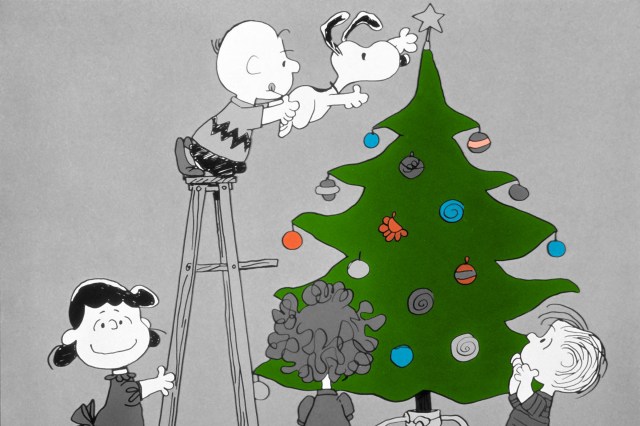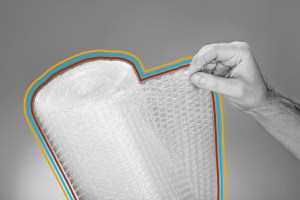
A New Kind of Fake Snow Was Created for “It’s a Wonderful Life”
The problem that plagues many holiday movies is how to create convincing snow when there isn’t any, and It’s a Wonderful Life (1946) director Frank Capra wasn’t satisfied with the bleached cornflakes that had been used to middling effect in other Hollywood features. Fortunately, RKO special-effects man Russell Shearman found a solution by mixing the carbon dioxide foam found in fire extinguishers with soap, sugar, and water. The resulting mix not only looked the part (and was much less noisy than cornflakes), but it also held up through fan-controlled applications that could be sped up to simulate a blizzard. More than enough of this “snow” was created to give the fictional Bedford Falls a wintry backdrop despite the film’s summertime shoot, and Shearman later received a technical achievement Oscar for his contribution to movie magic.

The Thanksgiving Day Parade in “Miracle on 34th Street” Was Real
Staging a parade in a movie can be an arduous undertaking with all the performers, set pieces, and choreography involved, but the creators of Miracle on 34th Street (1947) were fortunate to gain permission to hitch their wagons to New York City’s annual Macy’s Thanksgiving Day Parade in 1946. As co-star Maureen O’Hara recalled in her memoir, the experience of working around the event’s schedule was stressful for everyone involved: “They weren’t going to run the parade more than once on our account … It was a mad scramble to get all the shots we needed and we got to do each scene only once.” Nevertheless, the cameras got enough footage of Edmund Gwenn’s Kris Kringle waving to fans as he rode through Manhattan in Santa’s sleigh, and the authenticity of the scene set the tone for what became a true holiday classic of Hollywood’s golden age.

“White Christmas” Was Supposed To Pair Fred Astaire With Bing Crosby
Following the success of 1942’s Holiday Inn and 1946’s Blue Skies, 1954’s White Christmas was meant to once again pair the singing and dancing talents of Bing Crosby and Fred Astaire. When Astaire declined to participate over his dissatisfaction with the script, the role of Phil was offered to Donald O’Connor. When he was stricken with illness before production began, the casting merry-go-round ended with Danny Kaye stepping in. Crosby at one point also backed out of the movie following the death of his wife in 1952, before returning to play the part of Bob the following year.
More Interesting Reads

A Pioneering Japanese Stop-Motion Animator Was Behind “Rudolph the Red-Nosed Reindeer”
Tadahito Mochinaga created China’s first stop-motion puppet animation with a 1940s propaganda film mocking nationalist leader Chiang Kai-shek, and he created Japan’s first stop-motion puppet animation the following decade for a beer company. Those pioneering efforts caught the attention of American TV producers Arthur Rankin and Jules Bass, who tapped the Tokyo-based filmmaker to animate an adaptation of a Depression-era Christmas story turned hit holiday tune. Mochinaga brought his trademark detail to the project, even spending time in a Japanese deer sanctuary to better render the distinct features of the main characters. The mesmerizing result can still be witnessed many years later, as Rudolph the Red-Nosed Reindeer (1964) became the first in a string of popular Rankin/Bass seasonal holiday programs, en route to becoming the longest-running Christmas special in TV history.

Head Animator Bill Melendez Voiced Snoopy in “A Charlie Brown Christmas”
A Charlie Brown Christmas (1965) marked the Peanuts gang’s first major entry into the world of animated television. This brought numerous questions about how to translate the popular comic strip to the screen, among which was what to do about the voice of Snoopy. Although Peanuts creator Charles Schulz wanted to downplay Snoopy’s role, head animator Bill Melendez insisted on enhancing the beagle’s personality through his voice, and set about recording a series of noises that he hoped could be replicated by a trained voice actor. With time running out to finish the special, Melendez went with the sped-up, higher-pitched recordings he had been tinkering with instead of hiring another actor. Schulz was amused by Snoopy’s nonsensical ramblings, and Melendez was rewarded with the responsibility of voicing Charlie Brown’s pet for subsequent TV specials and animated features.

Flick’s Tongue Wasn’t Really Stuck to the Flagpole in “A Christmas Story”
You may have already figured there was nothing approaching actual danger for the actor in this enduring scene of A Christmas Story (1983), although clever set design ensured that the visual of a tongue stuck to a frozen flagpole seemed real enough. According to actor Scott Schwartz, the pole was wrapped with a layer of plastic, through which a clear tube ran down to a motorized vacuum buried in the snow. When Schwartz’s Flick plugged his tongue into a tiny hole in the plastic, the tube’s suction was strong enough to keep his organ in place, but mild enough to be easily withdrawn. All in all, it was painless enough for Schwartz to shoot the entire scene twice — after the first round of footage was damaged by underdeveloped film.

“Planes, Trains and Automobiles” Was Based on a True Story
Back when acclaimed screenwriter and director John Hughes was an unknown advertising copy man, he regularly traveled from Chicago to New York City on behalf of a client. During one blustery winter day, strong winds nixed the return flight to Chicago and forced him to find a hotel for the night. More cancellations awaited the following day due to deteriorating weather in the Midwest, and Hughes wound up on a flight that was rerouted to Des Moines, Iowa, and then Denver, Colorado, before he decided to remain on board for the sunnier destination of Phoenix, Arizona. Hughes eventually made it to Chicago five days later than originally planned, the torturous experience leaving a lasting imprint that became the basis of his 1987 Thanksgiving travel comedy Planes, Trains and Automobiles.

Macaulay Culkin’s Iconic Facial Gesture in “Home Alone” Was Improvised
Even fans who haven’t seen Home Alone (1990) in eons can recall the image of Macaulay Culkin, as the abandoned Kevin McCallister, slapping aftershave on his face and screaming into the mirror. However, that scene didn’t quite go according to plan; most people would move their hands after creating a burning sensation on their face, and director Chris Columbus instructed his young star to do so. Instead, Culkin kept his hands glued to his face as he screamed at his reflection, prompting everyone else to break up in laughter. Although different reactions were tried in subsequent takes, it was that first one that stuck and became a defining moment of the immensely successful comedy despite encompassing a tiny fraction of the 103-minute running time.

The Shower-Duet Scene in “Elf” Was Written for Actress Zooey Deschanel
While Elf (2003) was built around the physical comedic chops and man-child persona of star Will Ferrell, the endearing scene of Ferrell’s Buddy discovering Jovie singing in the shower didn’t take shape until Zooey Deschanel joined the production. According to Deschanel, the scene was initially a fluid one that would showcase the individual talent of the actress cast as Jovie; once her crooning abilities became apparent, the specifics of Buddy naively wandering into the women’s changing room fell into place. An added bonus was Ferrell’s surprisingly solid pipes, which brings a layer of sweetness to the building tension until Jovie inevitably realizes Buddy’s presence and orders him out.












